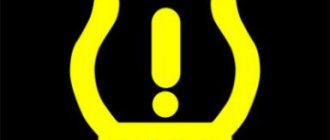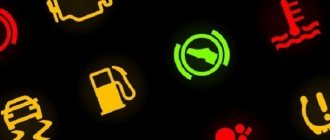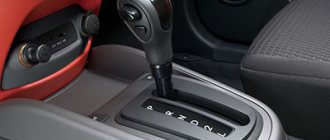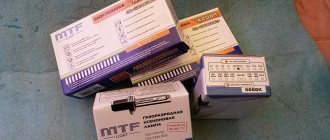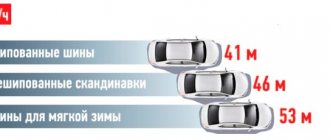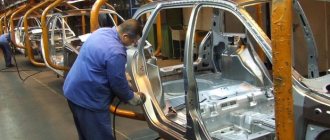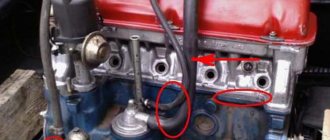Effective area of sign 4.1.1 “Move straight ahead”
Any of the signs 4.1.1 - 4.1.6 applies to the intersection of roadways in front of which they are installed. This means that if there are several crossings of roadways at an intersection, sign 4.1.1 will only apply to the one in front of it.
In the figure above, we need to select the allowed directions of movement at the intersection. Please note that before the first intersection of roadways there is a sign 4.1.1, which obliges you to drive straight through this intersection. This means that movement along trajectory B is prohibited. However, at the second intersection the sign has already lost its “power”, and we have every right to travel along trajectory A. As a result, we can move along trajectories A and B (Ticket 15 question 2)
If there is only one intersection of roadways at the intersection, then we get the following picture:
The intersection in the picture has one intersection of roadways, which obliges us to drive straight through the ENTIRE intersection. If you need to turn around, you can do this before the sign, or after passing the intersection. You cannot maneuver (turn or turn around) at the intersection of roadways (Ticket 13 question 2)
Let us recall that we examined in some detail how to determine how many roadway intersections an intersection has, and what this depends on
Roundabout Circulation
Sign 4.3 “Roundabout” notifies the beginning of a traffic circle:
- when entering the ring, you must slow down the pace of movement;
- movement around the ring occurs exclusively counterclockwise;
- a turn is performed after driving a full circle;
- before the beginning of the roundabout, in addition to symbol 4.3, there are often signs 2.4 “Give way” or 2.5 “Driving without stopping is prohibited”;
- on a ring equipped with traffic lights, participants move according to the permitting signals.
A roundabout looks safer than a traditional one due to the lack of direct intersection of traffic flows. However, accidents happen here too. This happens, first of all, due to ignorance of the principle: the ring is almost always the main road. Some motorists, when entering the roundabout, believe that traffic moving in a circle should let them through, because they are an obstacle to it on the right.
Approaching a roundabout requires the driver to adhere to the posted speed limit, evaluate the symbols present, and follow the traffic rules around the roundabout.
If sign 4.1.1 is installed outside the intersection (at the beginning of the road section)
With this arrangement of this prescriptive sign, the situation changes slightly. It still obliges the driver to move in a straight direction, but with some changes:
- if sign 4.1.1 is NOT installed before the intersection of roadways, then its effect now extends right up to the next intersection;
- with this installation, the sign allows you to turn RIGHT and only into courtyards (or other adjacent territory);
- the sign does not prohibit such maneuvers as: changing lanes, overtaking, reversing;
Examples when sign 4.1.1 is not placed before the intersection:
Actually, the question is based on the picture: which courtyard can you turn into after the intersection?
We look carefully at the image. Sign 4.1.1 is installed BEHIND the intersection of carriageways at the beginning of the road section. This means that it is valid until the next intersection. But at the same time, it does not prohibit turning right into the adjacent territory, including into the courtyard. Hence the answer - you can only go into the yard to the right
. (Ticket 16 question 2)
Another example (picture above): is it possible for a driver to drive up to a pedestrian in reverse (to pick up a girl, for example)?
We again draw attention to the fact that the sign is installed on an arbitrary section of the road where there are no roadway intersections. This means that no one forbade you to move in reverse. The answer is yes
(Ticket 28 question 9)
Road signs for traffic rules 2022 - symbols and images
Prohibition signs introduce or remove certain traffic restrictions.
3.1
3.1 “Entry is prohibited.”
Entry of all vehicles in this direction is prohibited.
3.2
3.2 “Movement is prohibited.”
All vehicles are prohibited.
3.3
3.3 “The movement of motor vehicles is prohibited.”
3.4
3.4 “Truck traffic is prohibited.”
The movement of trucks and vehicle combinations with a permissible maximum weight of more than 3.5 tons (if the weight is not indicated on the sign) or with a permissible maximum weight more than indicated on the sign, as well as tractors and self-propelled vehicles is prohibited.
Sign 3.4 does not prohibit the movement of trucks intended for the transport of people, vehicles of federal postal organizations having a white diagonal stripe on the side surface on a blue background, as well as trucks without a trailer with a permissible maximum weight of not more than 26 tons that serve enterprises located in the designated area. In these cases, vehicles must enter and exit the designated area at the intersection closest to their destination.
3.5
3.5 “Motorcycles are prohibited.”
3.6
3.6 “Movement of tractors is prohibited.”
The movement of tractors and self-propelled vehicles is prohibited.
3.7
3.7 “Moving with a trailer is prohibited.”
It is prohibited to drive trucks and tractors with trailers of any type, as well as tow motor vehicles.
3.8
3.8 “The movement of horse-drawn carts is prohibited.”
The movement of horse-drawn carts (sleighs), riding and pack animals, as well as the passage of livestock is prohibited.
3.9
3.9 “Bicycles are prohibited.”
Bicycles and mopeds are prohibited.
3.10
3.10 “Pedestrian traffic is prohibited.”
3.11
3.11 “Weight limitation”.
The movement of vehicles, including combinations of vehicles, the total actual weight of which is greater than that indicated on the sign, is prohibited.
3.12
3.12 “Limitation of mass per vehicle axle.”
It is prohibited to drive vehicles whose actual weight on any axle exceeds that indicated on the sign.
3.13
3.13 "Height limitation".
The movement of vehicles whose overall height (with or without cargo) is greater than that indicated on the sign is prohibited.
3.14
3.14 "Width limitation".
It is prohibited to drive vehicles whose overall width (laden or unladen) is greater than that indicated on the sign.
3.15
3.15 "Length limitation".
The movement of vehicles (vehicle trains) whose overall length (with or without cargo) is greater than that indicated on the sign is prohibited.
3.16
3.16 “Minimum distance limitation.”
It is prohibited to drive vehicles with a distance between them less than that indicated on the sign.
3.17.1
3.17.1 “Customs”.
It is prohibited to travel without stopping at a customs office (checkpoint).
3.17.2
3.17.2 "Danger".
The further movement of all vehicles without exception is prohibited due to a traffic accident, accident, fire or other danger.
3.17.3
3.17.3 "Control".
Driving through checkpoints without stopping is prohibited.
3.18.1
3.18.1 “Right turns are prohibited.”
3.18.2
3.18.2 “Left turns are prohibited.”
3.19
3.19 “Turning is prohibited.”
3.20
3.20 “Overtaking is prohibited.”
It is prohibited to overtake all vehicles except slow-moving vehicles, horse-drawn carts, bicycles, mopeds and two-wheeled motorcycles without sidecars.
3.21
3.21 “End of the no-overtaking zone.”
3.22
3.22 “Overtaking by trucks is prohibited.”
It is prohibited for trucks with a permissible maximum weight of more than 3.5 tons to overtake all vehicles.
3.23
3.23 “End of the no-overtaking zone for trucks.”
3.24
3.24 “Maximum speed limit.”
It is prohibited to drive at a speed (km/h) exceeding that indicated on the sign.
3.25
3.25 “End of maximum speed limit zone.”
3.26
3.26 “Sound signal is prohibited.”
It is prohibited to use sound signals, except in cases where the signal is given to prevent a traffic accident.
3.27
3.27 “Stopping is prohibited.”
Stopping and parking of vehicles is prohibited.
3.28
3.28 “Parking is prohibited.”
Parking of vehicles is prohibited.
3.29
3.29 “Parking is prohibited on odd days of the month.”
3.30
3.30 “Parking is prohibited on even days of the month.”
When signs 3.29 and 3.30 are used simultaneously on opposite sides of the roadway, parking is permitted on both sides of the roadway from 19:00 to 21:00 (rearrangement time).
3.31
3.31 “End of the zone of all restrictions.”
Designation of the end of the coverage area simultaneously for several signs from the following: 3.16, 3.20, 3.22, 3.24, 3.26 - 3.30.
3.32
3.32 “The movement of vehicles with dangerous goods is prohibited.”
The movement of vehicles equipped with identification signs (information plates) “Dangerous cargo” is prohibited.
3.33
3.33 “The movement of vehicles with explosive and flammable cargo is prohibited.”
The movement of vehicles transporting explosives and products, as well as other dangerous goods subject to marking as flammable, is prohibited, except in cases of transportation of these dangerous substances and products in limited quantities, determined in the manner established by special transportation rules.
Signs 3.2 - 3.9, 3.32 and 3.33 prohibit the movement of the corresponding types of vehicles in both directions.
The signs do not apply to:
3.1 - 3.3, 3.18.1, 3.18.2, 3.19 - for route vehicles;
3.27 - for route vehicles and vehicles used as passenger taxis, in places where route vehicles stop or where vehicles used as passenger taxis are parked, marked with markings 1.17 and (or) signs 5.16 - 5.18, respectively.
3.2, 3.3, 3.5 - 3.8 - on vehicles of federal postal service organizations that have a white diagonal stripe on a blue background on the side surface, and vehicles that serve enterprises located in the designated area, and also serve citizens or belong to citizens living or working in the designated area. In these cases, vehicles must enter and exit the designated area at the intersection closest to their destination;
3.28 – 3.30 – for vehicles driven by disabled people, transporting disabled people, including disabled children, if the identification mark “Disabled” is installed on these vehicles, as well as for vehicles of federal postal service organizations that have a white diagonal stripe on the side surface on a blue background, and in a taxi with the taximeter on;
3.2, 3.3 – for vehicles driven by disabled people of groups I and II, transporting such disabled people or disabled children, if the identification sign “Disabled” is installed on these vehicles;
The coverage area of signs 3.16, 3.20, 3.22, 3.24, 3.26-3.30 extends from the place where the sign is installed to the nearest intersection behind it, and in populated areas, in the absence of an intersection, to the end of the populated area. The effect of the signs is not interrupted at exit points from areas adjacent to the road and at intersections (junctions) with field, forest and other secondary roads, in front of which the corresponding signs are not installed.
The effect of sign 3.24, installed in front of a populated area indicated by sign 5.23.1 or 5.23.2, extends to this sign.
The coverage area of signs may be reduced:
for signs 3.16 and 3.26 using plate 8.2.1;
for signs 3.20, 3.22, 3.24 by installing signs 3.21, 3.23, 3.25 at the end of their coverage area, respectively, or using plate 8.2.1. The coverage area of sign 3.24 can be reduced by installing sign 3.24 with a different maximum speed value;
for signs 3.27-3.30 by installing at the end of their validity repeated signs 3.27-3.30 with plate 8.2.3 or using plate 8.2.2. Sign 3.27 can be used in conjunction with marking 1.4, and sign 3.28 - with marking 1.10, while the coverage area of the signs is determined by the length of the marking line.
Signs 3.10, 3.27-3.30 are valid only on the side of the road on which they are installed.
Penalty for sign 4.1.1 “Move straight”
According to Art. 12.16 of the Code of Administrative Offenses of the Russian Federation, the punishment for violating the instructions of sign 4.1.1 may depend on which of the prohibited maneuvers the driver performed:
- turn right at sign 4.1.1
is punishable by a fine of 500 rubles. Let us remind you that the sign does not prohibit turning into courtyards to the right (Part 1 of Article 12.16 of the Administrative Code);
- turn left or turn at sign 4.1.1
punishable by a fine of 1000-1500 rubles; (Part 2 of Article 12.16 of the Administrative Code)
- if after a turn (even to the left, even to the right) or a U-turn, the driver enters a road (roadway) with one-way traffic “against the grain,” then in this case he will be subject to a fine of 5,000 rubles or deprivation of his driver’s license for 4-6 months; (Part 3 of Article 12.16 of the Administrative Code)
Bike Lane
Sign 4.4.1 “Bicycle path” notifies the beginning of an individual route for cyclists.
The highway is equipped with a lane for two-wheeled vehicles with a maximum speed of no higher than 40 km/h. The designation is mounted:
- to the right of the path, when the demarcation is represented by green spaces and other objects;
- above the track together with the designation 8.14, when the border is marking 1.1.
After forks with highways and alternative routes, the symbol is duplicated.
Sign 4.4.2 “End of the bicycle path” notifies the end of one mode of movement and the beginning of the next. Now cyclists will have to travel on the road along with vehicles. They have to be extremely careful and follow the traffic rules regulating the designated order of movement.
The symbol is installed before the end of the bicycle path or lane.
How to avoid punishment
You can try to avoid the fine. This is not easy to do, but it is possible. If you carefully study the traffic rules, then in addition to the installed signs, there should be appropriate markings in the areas. They are the ones who can help you get out of the situation.
When the markings are almost invisible, no one can punish you for violating them. This is especially true in cases where there is no “Go straight ahead” sign. The Plenum of the Supreme Court of the Russian Federation even once gave its comment on this issue. And it sounds like this: “No markings - no punishment.”
Perhaps this is the only case when a driver has a real opportunity to avoid a fine for turning in the wrong place. To be on the safe side, you can install a DVR in your car. After all, traffic police officers often insist that drivers violate the rule of the “Go straight ahead” sign and turn around/turn in places other than where it is permitted.
Now we understand the next road sign. And all the nuances of his work too. Pay attention to road markings and sign position. This will help you decide exactly how to behave when driving a car. In any case, the “Go Straight” rule is easier to comply with than many other restrictions. The main thing is to know about all the nuances of the location of the corresponding sign.
Are there any exceptions
The traffic rules contain exceptions for the “No Stopping” sign. For example, if a special sign “Except for the disabled” is installed nearby, this means that citizens with disabilities can park here.
But even without this designation, the ban can be ignored:
- persons with disabilities of groups I and II with identification marks on the car and supporting documents;
- Russian Post vehicles;
- drivers of public transport (trolleybuses, trams, buses). These vehicles may stop near the sign to pick up/drop off passengers.
In all other cases, the prohibition must be followed.
Reversals and turns in the same sign
2.6 “River to oncoming traffic” and 2.7 “Target of oncoming traffic”
2.6 and 2.7 do not regulate the order of turns or U-turns, these are priority signs that indicate on a narrow section of the road who should give way to whom. They are extremely rare, but nevertheless they must be followed.
Sign 2.6 - “Right of way for oncoming traffic”
Easy to remember: a sign in a red circle usually indicates that something is prohibited. If you see him, stop to let oncoming cars pass.
The driver may well stop and check the meaning of the sign in the directory. This is not prohibited by traffic rules; moreover, a decision made in haste can greatly worsen the situation on the road and cause an accident, which will definitely cause more harm.
Sign 2.7 - “Take advantage of oncoming traffic”
If it's blue, the road is yours.
Sign 3.18.2 “Left turn prohibited”
It’s easy to remember: if the sign is in a red circle, then it is prohibitive. If the red line crosses out the direction, it’s all the more clear that you can’t go there. But many do not know that it has nothing to do with turning around and only prohibits left turns, and nothing else.
Prohibits left turns Allows turns
Service marks
Service signs inform about the location of the relevant facilities.
| Sign number | Image | Name |
| 7.1 | First aid station | |
| 7.2 | Hospital | |
| 7.3 | Gas station | |
| 7.4 | Car maintenance | |
| 7.5 | Car wash | |
| 7.6 | Telephone | |
| 7.7 | Food point | |
| 7.8 | Drinking water | |
| 7.9 | Hotel or motel | |
| 7.10 | Camping | |
| 7.11 | Resting-place | |
| 7.12 | Road patrol post | |
| 7.13 | Police | |
| 7.14 | International road transport control point | |
| 7.15 | Reception area of a radio station transmitting traffic information | |
| 7.16 | Radio communication area with emergency services | |
| 7.17 | Pool or beach | |
| 7.18 | Toilet | |
| 7.19 | Emergency phone number | |
| 7.20 | Fire extinguisher |
What does it mean
The “Parking prohibited” designation indicates that drivers are prohibited from stopping or parking in the area of its influence:
- You cannot stop driving a car for a period of up to 5 minutes or more, which is associated with unloading (loading) goods or boarding (disembarking) passengers.
- Stopping for more than 5 minutes is prohibited.
The area covered by the “No Parking (Stop)” sign with arrow is defined below.
In which directions are you allowed to continue driving?
| 1. | ? | Only to the left. |
| 2. | ? | Only in the opposite direction. |
| 3. | ? | To the left and in the opposite direction. |
An additional section with a green arrow signal on, a “Lane Directions” sign and marking 1.18 allow you to turn left or make a U-turn from the left lane.
4.5.2 Pedestrian and bicycle path with combined traffic
Symbol 4.5.2 regulates the movement of pedestrians and bicycle owners along the same line.
The space is also used by owners of mopeds and scooters, since their vehicles have a travel speed below 40 km/h. There is no place for vehicles on the territory of the mandatory sign, except for:
- Vehicles delivering goods to objects in the area where the sign is active (if there are no other access routes);
- special vehicles of various services.
The territory of symbol activity extends from the installation point to the next fork.
Sign 4.5.3 “End of pedestrian and cycle path with combined traffic” informs pedestrians and bicycle owners about the end of a special section and the beginning of a different route plan. Participants should exercise caution when planning and structuring travel routes.
The installation of the symbol takes place on the territory where the general movement ends.
Signs 4.5.4 and 4.5.5 separate the paths for pedestrians and cyclists in the same area. The symbolism tells which row the participants should take. The rows are broken up by a border, lawn or markings.
Signs 4.5.4 and 4.5.5 regulate the end of the previous mode of movement of pedestrians and cyclists. From this moment on, they will have to double their attentiveness and caution, thinking through ways of a safe route.
The symbols are mounted at the end point of the bicycle pedestrian section.
What does a traffic light signal in the form of a red arrow inform you about?
| 1. | ? | Right turns are always prohibited at this intersection. |
| 2. | ? | Turning right is permitted, but you must give way to pedestrians. |
| 3. | ? | When the traffic light turns green, traffic will only be allowed to the right. |
The traffic light signal in the form of a red arrow informs you that only traffic to the right is allowed from this lane. You can make a turn after turning on the signal in the form of a green arrow.
End of minimum speed limit zone
Sign 4.7 signals the end of the activity of symbol 4.6 and returns the ability to move at convenient speed values. It is installed at the end of a section of highway or lane before the end of the minimum speed regulation space. Typically, the designation 4.7 is relevant on highway turns and climbs that limit visibility for the motorist.
And the last point that every car enthusiast should know: mandatory signs are often used together with various symbols of additional information in the form of signs that clarify or limit the effect of these signs. Therefore, such pointers must be read together.
Post Views: 21
What should a driver do when changing such a traffic light?
| 1. | ? | When the red signal turns on, turn right, giving way to other road users. |
| 2. | ? | When the green signal turns on, continue moving only to the right. |
| 3. | ? | The above actions are correct in both cases. |
The traffic light signal in the form of a yellow arrow informs you that only right-hand traffic is allowed from this lane. You can make a turn after turning on the signal in the form of a green arrow.
4.5.1 Pedestrian path
Sign 4.5.1 indicates a section of the route reserved for pedestrian participants. In the field of operation of the symbol, movement and parking of any transport are excluded.
However, the requirement has a number of nuances:
- Vehicles may enter the territory to deliver goods to stores located here. But first, the driver must make sure that there are no other ways to access the store. The driver is obliged to move at a minimum speed, choosing the shortest route through the territory, and also respect the safety of pedestrians.
- Movement in the pedestrian zone is permitted for vehicles of municipal and road maintenance departments operating on this section of the road.
- Cyclists, moped and scooter drivers are allowed to move along the lane after getting off their vehicles.
The symbol is active from the mount point until the fork is overcome.
Other mandatory road signs.
The following signs are a combination of those already studied
Move straight or to the right.
orders to move straight or to the right
But we take into account the lane, the sign hangs straight and to the right, but the lane to the right is not the right one. To turn right you need to move in the far right lane; turning right from the far left is prohibited. In the picture above, the only correct trajectory is B.
Movement straight or left.
orders straight ahead and to the left, including allowing a U-turn.
Movement to the right or left.
points to the right or left
The coverage area of all mandatory signs whose name begins with the word “traffic” is the first intersection of roadways.
Avoid obstacles on the right.
For what
The effect of the “Go straight” sign is not prohibitive, like most signs. It is prescriptive. And of course, a positive connotation. Indicates that the driver must (obliged) follow the direction shown on the pole.
But this sign is quite insidious. Novice drivers often face huge problems with the “Go Straight” sign. According to the rules, depending on the position of the pole, the rules of behavior on the roads change. Therefore, all the nuances associated with this index will have to be learned.
Description
Before we talk about the rules of action, you will have to learn to distinguish the “Move straight” sign from all the others. This is not so difficult, because its distinctive features are very simple.
What does our index look like today? This is nothing more than a blue circle with an arrow. It is white and points upward. This is the “Go straight ahead” sign. It is easy to distinguish him from all the others. Just a white up arrow on a blue or light blue background in a circle. On the road, such a symbol stands out well.
Sign to avoid obstacles on the right or left
The sign “Avoiding an obstacle on the right or left” allows detour on both the right and the left:
Signs 4.2.1-4.2.3 are usually installed at the beginning of the fence along the axis of the roadway, at the beginning of the dividing strip, as well as in the presence of other obstacles on the roadway. For example, when carrying out repair work on the road. These signs can be installed on special stands.
I would like to note that violation of the requirements of signs 4.2.1-4.2.3 may result in the car ending up in the oncoming lane. Currently, for such a violation, the driver can be deprived of his license for a period of 4 to 6 months.
The next article in the “Traffic Signs” series will talk about several new mandatory traffic signs.
The revision came into force on November 5, 2014.
Changes were made in accordance with Decree of the Government of the Russian Federation dated October 24, 2014 No. 1097.
Warning signs inform drivers that they are approaching a dangerous section of the road, driving along which requires taking measures appropriate to the situation. The numbering of road signs corresponds to GOST R 52290-2004.
Priority signs establish the order of passage through intersections, intersections of roadways or narrow sections of the road.
Prohibition signs introduce or remove certain traffic restrictions.
Compliance with the requirements of prescriptive signs is mandatory if traffic management is not carried out by a traffic controller.
Special regulations signs introduce or cancel certain traffic modes.
Information signs inform about the location of populated areas and other objects, as well as established or recommended traffic modes.
Service signs inform about the location of the relevant facilities.
Additional information signs (plates) clarify or limit the effect of the signs with which they are used.
Identification signs or plates serve to limit or clarify the effect of the sign with which they are used.
Information about road signs
A road sign, or traffic sign, is a graphic design made in accordance with certain standards and installed near the road in order to bring certain information to the attention of road users.
The role of road signs in ensuring traffic safety is extremely large: they inform drivers about dangerous sections of the road, oblige them to reduce speed, prohibit overtaking where it is associated with an increased risk, and perform many other useful tasks. Modern standards that determine the appearance of road signs, as well as markings and traffic lights, came into force in our country on January 1, 2006. The updated signs are fully compliant with the UN Convention on Road Signs and Signals and the latest European standards in the relevant field.
Penalties
Parking under a prohibited sign may cause inconvenience to other road users. Therefore, for ignoring this sign, a fine will be imposed on the driver. In addition, the car can be towed to an impound lot, which will also entail additional expenses for the motorist (services of a tow vehicle, staying at the impound lot). A sign that warns of the possibility of evacuation (8.24) is installed within the scope of the special sign prohibiting parking.
The standard penalty for parking under a “No Parking” sign is 500 rubles. The Code of Administrative Offenses of the Russian Federation provides for several clarifications:
- The amount of the fine will be increased to 3-5 thousand rubles if only persons with disabilities can park in the designated special zone.
- If a motorist creates a dangerous situation that interferes with the movement of other vehicles, then the amount of the penalty will be 2 thousand rubles.
- If a similar situation arises in a city of federal significance, the driver will need to pay 2.5-3 thousand rubles. with the possibility of auto evacuation.
To summarize, it is important to clarify that the effect of the “No Stopping” sign with an arrow down extends to the territory up to the place where this sign is installed. Drivers must strictly adhere to this rule to avoid receiving an administrative penalty.
Punishment
Violation of the “Go straight” sign is still punishable by law. Not very harsh, because this is not a prohibitory symbol. Nevertheless, certain measures to combat violators take place.
Most often this is a verbal warning or reprimand. Rest assured, if there is a movement violation, you will definitely get it. But you won't get off that easy. After all, there is also a fine for a “Go straight” sign.
At the moment it is 500 rubles. In some cases, the amount of payments can increase to 1500. It all depends on the situation as a whole. Practice shows that most often drivers pay 500 rubles to a traffic police officer, listen to the traffic rules, receive a verbal reprimand and continue their journey.
In this case, no one has the right to deprive of rights and confiscate the vehicle. Only with rare exceptions. And they apply only to citizens who constantly violate the law and traffic rules on the roads. Here it should be assumed that the vehicle will be sent to the impound lot. Plus, you will be fined a certain amount (from 500 to 1500 rubles), and you will also have to buy the car. This is another additional expense in the form of several thousand.



